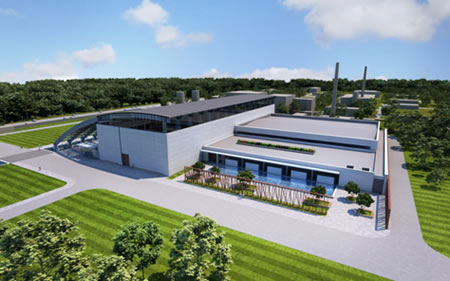
Extreme Light Infrastructure – Nuclear Physics (ELI-NP)
By Ovidiu Tesileanu and Nicolae-Victor Zamfir
‘Horia Hulubei’ National Institute of Physics and Nuclear Engineering,
Bucharest-Magurele, Romania
The Extreme Light Infrastructure (ELI) is a major European Infrastructure project that is to be carried out in three European countries - the Czech Republic, Hungary, and Romania.
The Nuclear Physics pillar, ELI-NP, located in the Magurele Physics Research Campus, near Bucharest, Romania, will be funded from Structural Funds provided within the framework of the Sectorial Operational Programme called Increasing Economic Competitiveness.

When it starts up, the ELI-NP will be the most advanced research facility in the world focusing on the study of nuclear physics studies and its applications - a task it will accomplish with the help of two 10PW, ultra-short pulse lasers and the most brilliant tunable gamma-ray beam machine currently available in the world. This €290M project will be built between 2012 and 2016. The facility will be dedicated to working in fields such as frontier fundamental physics, new nuclear physics and astrophysics, as well as on applications for studying nuclear materials and radioactive waste management, materials science and life sciences.
The brilliant gamma ray beam that provides tunable energy of up to 20 MeV, which is obtained by the back-scattering of optical photons on electrons from a LINAC beam that generates energy of up to 720 MeV. This machine will open up new possibilities for high resolution spectroscopy at higher nuclear excitation energy levels. With their many doorway states, damping widths and chaotic behaviour they will lead to a better understanding of nuclear structure at a large range of excitation energy levels.
With regards to ion acceleration, this high power laser allows the production of 1015 times denser ion beams than are currently achievable with classical acceleration. The cascaded fission-fusion reaction mechanism can then be used to produce very neutron-rich heavy nuclei for the first time, which are relevant for analysis of nucleosynthesis.
The gamma beam itself can be used to map the isotope distributions of nuclear materials or radioactive waste remotely via Nuclear Resonance Fluorescence (NRF) measurements. At lower energy levels of around 100 keV the high resolution of the beam is very important for protein structural analysis. In addition, it will produce low energy, brilliant, intense neutron and positron beams, which will open up new research possibilities in the fields of materials science and life sciences.
Compared to former gamma-ray machines, the much improved bandwidth of this machine is decisive to the functioning of this new facility. Several experiments, like a parity violation experiment, only become possible thanks to this much improved bandwidth.
In addition to enabling the carrying out of a wide range of fundamental physics projects, ELI-NP will also facilitate a variety of other applied research projects. The new production schemes for the production of medical isotopes via (γ,n) will have high socio-economical relevance. ELI-NP will be implemented in this field using the highest concentration of researchers from Central and Eastern Europe specialised in the laser and nuclear physics. The high density of innovative companies located in the region, as well as top-ranked universities in Bucharest, will provide the basis for the creation of a pole of excellence and an innovation cluster at the facility. ELI-NP will thus impact positively not only fundamental science, but also on the industrial community at both a local and international level. Its social impact in Romania is of major importance to counteract the country’s brain drain, by providing the motivation for top young researchers - who might otherwise seek to go abroad in search of better professional opportunities at large scale research centres - to remain in Romania.
ELI-NP will allow for applied R&D in unrivalled conditions, which will prove important for companies active in the fields of medicine (radionuclides and hadron-therapy), telecommunications (materials in high intensity radiation fields), engineering industry (non-destructive testing), security (scanners based on nuclear resonance fluorescence of sensitive nuclear materials) – to name just a few.
Collaboration with universities in Romania and abroad are - and will be - established, for the mutual benefit of the community and of the infrastructure, by providing staff and students of academic institutions the opportunity to work in a cutting-edge facility. The facility will also provide staff and students with a chance to receive specialised training within the scope of ELI-NP.
The policy of access to ELI-NP, as well as to the other ELI centres, will be on eof open access, free for members of the scientific community. Paid access will be granted to companies.
The buildings will be completed by the end of 2014 and the new facility will inaugurated in 2016, with the operational phase starting at the beginning of 2017. Employing over 200 full-time researchers and engineers (including 60 PhD students), ELI-NP will be visited by a large number of external research teams each year, teams selected by an international committee based exclusively on the quality of their research proposals.

|

